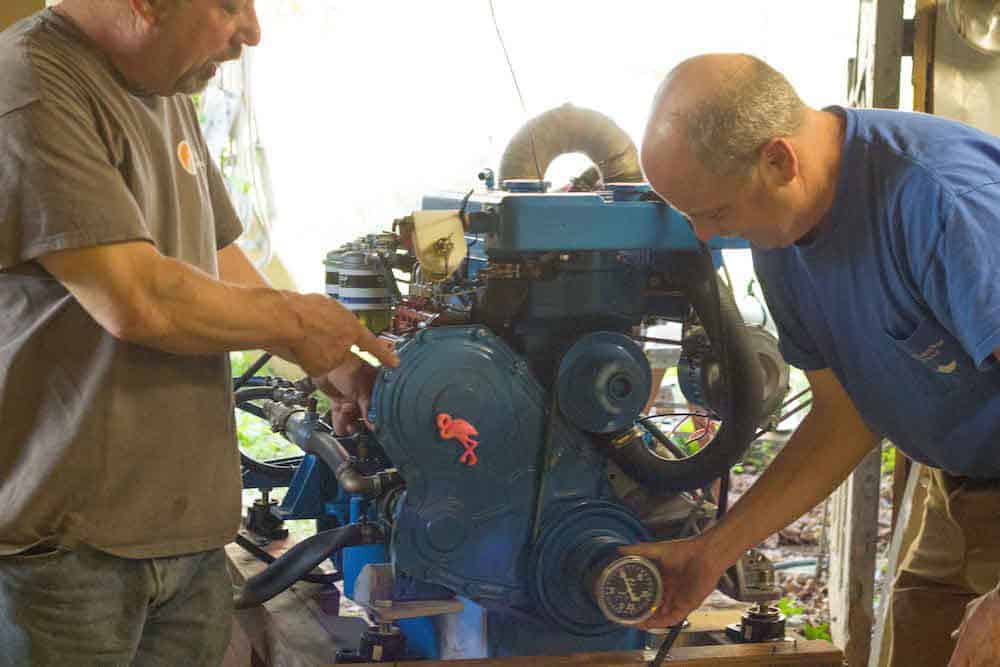Last fall I was too absorbed in marinizing BONNY BRIDE’S rebuilt Ford diesel and trying to get its 2.5:1 Paragon gear to operate properly to post any more progress reports on OCH. It was a steep learning curve for me, and I fell down the rabbit hole a few times. But now I’m ready to install the engine and its systems, which seem to be tight and functioning. And yes, it runs beautifully. Now for the story:
I decided that the 70hp Ford diesel, which I had in hand, coupled with the right gear, would give me seven or eight knots under good conditions with decent fuel economy. I plan to cruise in sheltered waters so won’t be needing a big, lobsterboat-type engine.
English-built Ford Lehmans seem to be ubiquitous in small trawlers and yachts, and there are excellent parts suppliers who charge fair prices and give good advice, once you learn diesel-speak from the overhaul manual.
This particular engine was built in England in the late 1960s, marinized in Sweden by Nils Gustavson, and installed in an Estonian-built, Alden schooner that sailed trans-Atlantic to Louisiana, and subsequently thru neglect sank at the dock there. My brother-in- law salvaged her and had started to rebuild the Ford Diesel in New Iberia before moving to Connecticut and abandoning the project. About five years ago he gave me the engine along with a crate of parts.
He had stripped the engine to the bare block and cleaned it. The cylinder head was off, but complete. New cylinder liners and rings had been installed along with connecting rods and main bearings. Everything else needed cleaning, de-rusting, inspecting and rebuilding. Yup, and assembling too. Fortunately two extremely clear and complete overhaul manuals, written in “British” English, came with the project. My friend Mike Franco, a master engine re-builder and marine mechanic, very generously offered to mentor me.
The new cylinder liners had not been honed, so, out came the crankshaft, rods and pistons. (New cylinder liners apparently need some scratching to help wear in the new rings. And I learned not to mix up the pistons, so each piston went back in its original hole.) While this was going on the local hotrod shop planed the head, ground the valves and seats, and told me to find three new valves. These I got from NAPA with “New Holland” agricultural logos on them! The shop also polished the crankshaft. Then it was assembly time.
The main bearing caps seemed loose so they we un-bolted them and checked them with Plastic Gauge—a micro straw that, when squeezed between bearing surfaces, measures clearances. The bearings proved to be way too loose, but the crankshaft measured to spec. What the Heck? It turns out that the block was bored oversized, so special bearings had to be ordered from the British Empire.
I spent a lot of time hovering over the parts washer and wire wheeling the rust off of various castings, stampings, nuts and bolts. (Parts washer fluid is serious stuff. My advice: wear heavy rubber gloves and safety glasses.) During the winter, in spare time, we got the Ford put back together. I bought a spare injection pump on e-Bay, since the original had been submerged, and on a very exciting afternoon in July we got this 30-year-old bunch of assorted parts to actually run! It even had excellent oil pressure.
The next step was marinizing—that is, putting on the special parts to make a basic industrial diesel suitable for marine service. I had to do this because most of the marine parts that came with it were either worn out or corroded beyond functioning. This meant adding an alternator, salt water pump, oil cooler, motor mounts, water-cooled manifold and a lot of wires and hoses. I quickly learned about wire and pipe sizes. At this point in the project, I acquired a second engine of the same model that was newer and had spare parts, many of which fit perfectly despite being painted red instead of blue.

Marine transmissions are very expensive. I lucked out and was able to buy at close to scrap price a 40-year-old 2.5:1 Paragon gear (model HF7). This ratio will let me swing a large, slow-turning propeller that should push BONNY BRIDE efficiently at hull speed. The ger’s interior was an astonishingly fine piece of machining, with big ball bearings and various bronze washers and clutch plates. (It was built in Taunton, Massachusetts, back when this country used to manufacture such things.) It had been previously disassembled and came without gaskets, but I was able to order a gasket kit and proceeded to put it back together, very encouraged by the lack of wear inside.
. . . sign up to the right to get immediate access to this full post,
plus you'll get 10 of our best videos for free.
Get Free Videos& Learn More Join Now!!for Full Access Members Sign In


Joel Plessala says:
The Alden schooner (581-B) the Lehman came from sunk in a shallow slip in a hurricane in 1992, was hauled and stored at a shipyard in New Iberia, Louisiana. Luckily the engine was not completely submerged. Unfortunately, the schooner, the only sister to the Hodgdon-built Spirit, burned in a shipyard fire in 2010. Ballast, sails, lower spars, some interior, and much hardware remain…
A good new home for the diesel. Joel